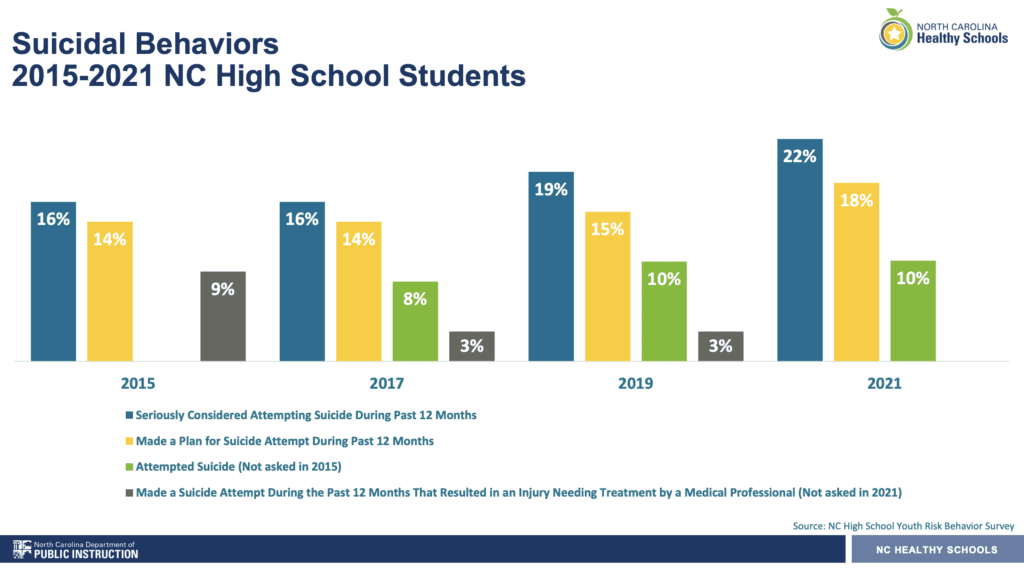This story was originally published by EducationNC on Dec. 14. Story by Liz Bell
Mental and emotional health challenges are increasing among North Carolina high school students, particularly those who identify as female, lesbian, gay, or bisexual, according to the 2021 NC Youth Risk Behavior Survey, the first since the pandemic began.
“This is the only survey in the state that uses student voice,” said Ellen Essick, section chief of NC Healthy Schools and Specialized Instructional Support at the Department of Public Instruction (DPI). “Everything else we do, we talk about students. This is where students talk about themselves.”
The biannual survey has been conducted in the spring of every odd year since 1993. Middle and high school students are randomly selected from throughout the state to participate. They can answer any or none of the questions. Essick said 1,759 high schoolers participated in 2021.
She shared takeaways from the high schoolers’ responses Monday at this year’s final meeting of the Child Fatality Task Force (CFTF), a group that studies trends in child deaths and recommends prevention strategies to the legislature and the governor. Essick will share more at the January meeting of the State Board of Education, she said.
Slightly higher reported suicidal behaviors
High school students reported slightly higher suicidal thoughts and behaviors than in 2019.
Respondents who reported seriously considering suicide rose from 19 percent to 22 percent. Those who said they made a plan for suicide went from 15 to 18 percent. Those who reported an attempted suicide held steady at 10 percent.

Among participants who identified as lesbian, gay, or bisexual, almost half (48 percent) had seriously considered suicide, compared with 15 percent of heterosexual respondents; 36 percent had made a plan, compared with 12 percent of heterosexual respondents; and 21 percent had attempted suicide, compared with 6 percent of heterosexual respondents.

Essick pointed out that the uptick in students who said they had seriously considered suicide is mostly due to an increase among females. In 2021, 30 percent of female respondents said they had seriously considered suicide, compared with 23 percent in 2019 and 15 percent a decade earlier, in 2011. In 2021, 14 percent of males had seriously considered committing suicide, compared with 15 percent in 2019 and 14 percent in 2011.

Dating violence reports double; mental health worsens
The percentage of high schoolers who said they had experienced physical dating violence nearly doubled, from 7 percent in 2019 to 13 percent in 2021.
“This really shocked us, and it has us worried,” Essick said. “… We’re scrambling to figure out where we need to change our intervention and prevention efforts, at least in public schools, from our perspective, and we’ll work with all of you on how to do that.”

From 2019 to 2021, the percentage of students who agreed or strongly agreed that they felt good about themselves fell from 60 to 49 percent. The percentage of students who agreed or strongly agreed that they felt alone went from 31 to 33 percent. The percentage of students who agreed with a definition of clinical depression went from 36 to 43 percent.

Thirty-four percent of high schoolers said their mental health was not good most of the time or always. Almost half of female high schoolers (46 percent) reported this, compared with 21 percent of males. Sixty percent of lesbian, gay, and bisexual students reported this, compared with 24 percent of heterosexual students. Sixty-nine percent of students who identified as “other or questioning” reported this.

Twenty-two percent of all high school respondents said they had purposely done something to hurt themselves without wanting to die, with similar trends: higher rates in female students and lesbian, gay, and bisexual students.
Thirty-one percent of female high school students, compared with 12 percent of male students, reported self-harm. Forty-nine percent of lesbian, gay, and bisexual students reported self-harm, compared with 13 percent of heterosexual respondents.

Vaping and bullying reportedly down
The percentage of students who said they had ever used an electronic vaping product fell significantly, from 52 percent in 2019 to 38 percent in 2021. Those who said they currently used a vaping product went from 36 percentin 2019 to 24 percent in 2021.

The percentage of students who said they had experienced electronic bullying slightly fell from 15 percent in 2019 to 13 percent in 2021. Those who said they were bullied on school property fell from 19 to 14 percent.

Safety concerns
Seventeen percent of respondents said they did not go to school because they felt unsafe on the way or at school, compared with 14 percent in 2019 and 10 percent in 2017.

Thirty percent of high school students reported it would take them less than an hour to get and be ready to fire a loaded gun without a parent or other adult’s permission. This was higher for males: 35 percent, compared with 24 percent of females.

Join the First Amendment Society, a membership that goes directly to funding TCB‘s newsroom.
We believe that reporting can save the world.
The TCB First Amendment Society recognizes the vital role of a free, unfettered press with a bundling of local experiences designed to build community, and unique engagements with our newsroom that will help you understand, and shape, local journalism’s critical role in uplifting the people in our cities.
All revenue goes directly into the newsroom as reporters’ salaries and freelance commissions.








